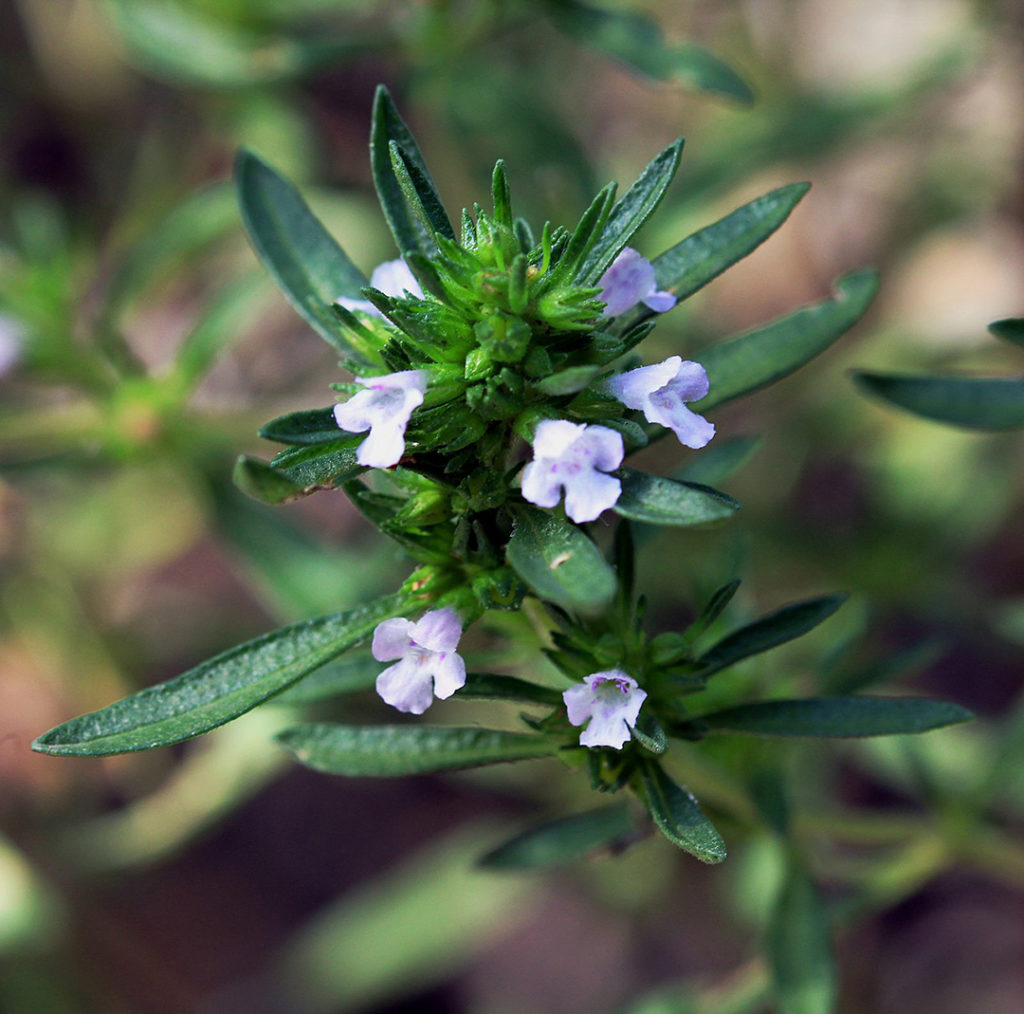
Bolivia
Savory
Satureja boliviana

General Description / Cultural Significance
Bolivia is a land-locked country in central South America. Its pre-colonial history dates back to ancient civilizations with small agricultural villages. Satureja boliviana is a native, highly aromatic, low-growing herb with whorl-shaped flowers on its stems. As long as people can remember, Savory, or Satureja boliviana, has been in use as flavoring and medicine. Today, its pharmacological and phytochemical characteristics make it an important species for food, pharmaceutical, and cosmetic industries. Its antimicrobial, antioxidant, antiviral, anti-inflammatory, and other phytochemical activities have kept it in continuous cultural use. A relative of rosemary and thyme, Satureja boliviana emits powerful volatile substances and its characteristic smell is well known across the country. One of the main constituents of its essential oil is piperitenone oxide. It is used to flavor food, and traditionally to treat nausea, cramps, and indigestion among other ailments. Today, it is most commonly taken as a soothing tea.
Climate Change/Conservation Status
The harsh reality of climate change is already affecting the lives of the people of Bolivia with devastating droughts, storms, and floods. The glaciers are rapidly receding. In 2015, the majority of the once-huge Lake Poopó had disappeared, leaving hundreds of fishing families without their livelihood. The lake’s disappearance has taken with it generations of cultural identity of the Uru-Murato people. It has also taken away the flamingo, which the people prized for its healing; the bird’s pink fat was used to relieve rheumatism, and its feathers were burned and inhaled to bring down fevers.
Bolivia’s contribution to global warming is around 0.06% and rising. This small percentage is due to the fact that it is a barely industrialized country. However, it is allowing deforestation to take place. Massive acres of the forest are destroyed every day, causing the emission of greenhouse gases. In 1984, it was determined that the Amazon was the main source of freshwater on Earth, representing 15-20% of the global river flow. This understanding helped unravel the massive effect that the hydrological cycle of the Amazon River Basin has on global climate. As climate change threatens the Amazon, its biodiversity loss affects the world globally.
It is anticipated that many species of Bolivia’s flora will disappear due to increase in temperatures and the inability of some of the species to adapt or migrate. The scarcity of drinkable water in some regions could be singularly the most devastating impact of climate change on Bolivia’s productivity and population.
Alternate Names
Satureja
Hierba aromática
Sources
BBC, 2020. Bolivia country profile. BBC News. [website]
Derks, S., 2018. Bolivia’s indigenous women cope with climate change. Al Jazeera. [website]
Director, Herbario Nacional de Bolivia. This statement can be found on the World Sensorium original website.
FAO, 2012. Human activity puts certain animal and plant species at risk in Bolivia. Food and Agriculture Organization of the United Nations. [website]
Momtaz, S., & Abdollahi, M., 2010. An update on pharmacology of Satureja species; from antioxidant, antimicrobial, antidiabetes and anti-hyperlipidemic to reproductive stimulation. International Journal of Pharmacology, 6(4), pp.346–353. DOI: 10.3923/ijp.2010.346.35
Postero, N.G., 2008. Now We Are Citizens: Indigenous politics in postmulticultural Bolivia, Stanford University Press, Stanford, CA
Senatore, F., et. al., 1998. Essential Oils from Two Peruvian Satureja Species. Flavour and Fragrance Journal, 13, pp.1-4. DOI: 10.1002/(SICI)1099-1026(199801/02)13:1<1::AID-FFJ672>3.0.CO;2-4
TeleSur, 2019. Bolivia Takes Action on Climate Change. La Nueva Televisión del Sur. [webiste]
Thomas, E., 2008. Quantitative Ethnobotanical Research on Knowledge and Use of Plants for Livelihood among Quechua, Yuracar and Trinitario Communities in the Andes and Amazon Regions of Bolivia. PhD-thesis. Faculty of Bioscience Engineering, Ghent University, Belgium, pp. 496.
Torres-Batlló, J., & Belen Marti-Cardona, B., 2021. Lake Poopó: Why Bolivia’s second largest lake disappeared – and how to bring it back. The Conversation. [website]
Viturro, C.I., et. al., 2000. Essential oils of Satureja boliviana and S. parvifolia growing in the region of Jujuy, Argentina. Flavour and fragrance Journal, 15(6), pp. 377-382. DOI: 10.1002/1099-1026(200011/12)15:63.3.CO;2-G
Walker, B., 2017. Climate Change Is Making this Bolivian Village a Ghost Town. Inside Climate News. [website]
Vandebroek, I., et al., 2004. A comparison of traditional healers’ medicinal plant knowledge in the Bolivian andes and Amazon. Social Science & Medicine, 59(4), pp.837–849. DOI: 10.1016/j.socscimed.2003.11.030

